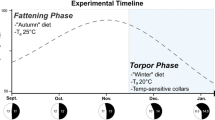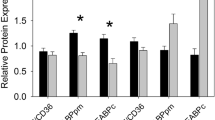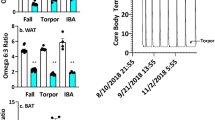Abstract
Diets rich in unsaturated and polyunsaturated fatty acids have a positive effect on mammalian torpor, whereas diets rich in saturated fatty acids have a negative effect. To determine whether the number of double bonds in dietary fatty acids are responsible for these alterations in torpor patterns, we investigated the effect of adding to the normal diet 5% pure fatty acids of identical chain length (C18) but a different number of double bonds (0, 1, or 2) on the pattern of hibernation of the yellow-pine chipmunk, Eutamias amoenus. The response of torpor bouts to a lowering of air temperature and the mean duration of torpor bouts at an air temperature of 0.5°C (stearic acid C18:0, 4.5±0.8 days, oleic acid C18:1, 8.6±0.5 days; linoleic acid C18:2, 8.5±0.7 days) differed among animals that were maintained on the three experimental diets. The mean minimum body temperatures (C18:0, +2.3±0.3°C; C18:1, +0.3±0.2°C; C18:2,-0.2±0.2°C), which torpid individuals defended by an increase in metabolic rate, and the metabolic rate of torpid animals also differed among diet groups. Moreover, diet-induced differences were observed in the composition of total lipid fatty acids from depot fat and the phospholipid fatty acids of cardiac mitochondria. For depot fat 7 of 13 and for heart mitochondria 7 of 14 of the identified fatty acids differed significantly among the three diet groups. Significant differences among diet groups were also observed for the sum of saturated, unsaturated and polyunsaturated fatty acids. These diet-induced alterations of body fatty acids were correlated with some of the diet-induced differences in variables of torpor. The results suggest that the degree of unsaturation of dietary fatty acids influences the composition of tissues and membranes which in turn may influence torpor patterns and thus survival of hibernation.
Similar content being viewed by others
Abbreviations
- bm:
-
body mass
- T a :
-
air temperature
- T b :
-
body temperature
- FA:
-
fatty acid
- MR:
-
metabolic rate
- MUFA:
-
monounsaturated fatty acids
- PUFA:
-
polyunsaturated fatty acids
- VO2 :
-
rate of oxygen consumption
- SFA:
-
saturated fatty acids
- UFA:
-
unsaturated fatty acids
- UI:
-
unsaturation index
- SNK:
-
Student-Newman-Keuls test
References
Aloia RC, Pengelley ET (1979) Lipid composition of cellular membranes of hibernating mammals. Chem Zool 11:1–48
Aloia RC, Raison JK (1989) Membrane function in mammalian hibernation. Biochim Biophys Acta 988:123–146
Arnold W (1990) Evolution of marmot sociality: II cost and benefits of joint hibernation. Behav Ecol Sociobiol 27:239–246
Broome LS, Mansergh IM (1990) The mountain pygmy possum Burramys parvus (Broom): an alpine endemic. In: Good R (ed) Proceedings of the first Fenner conference—the scientific significance of the Australian Alps. Australian Academy of Science, Canberra, pp 241–264
Coleman RA, Florant GL, Mostafa TX, Bhat BG (1993) Molecular mechanisms for selective retention of essential fatty acids during hibernation. In: Carey C et al. (eds) Life in the cold: ecological, physiological and molecular mechanisms. Westview Press, Boulder, pp 519–525
Florant GL, Nuttle LC, Mullinex DE, Rintoul DA (1990) Plasma and white adipose tissue lipid composition in marmots. Am J Physiol 258:R1123-R1131
Florant GL, Hester L, Ameenuddin S, Rintoul DA (1993) The effect of a low essential fatty acid diet on hibernation in marmots. Am J Physiol 264:R747-R753
Frank CL (1992) The influence of dietary fatty acids on hibernation by golden-mantled ground squirrels (Spermophilus lateralis) Physiol Zool 65:906–920
Geiser F (1990) Influence of polyunsaturated and saturated dietary lipids on adipose tissue, brain, and mitochondrial membrane fatty acid composition of a mammalian hibernator. Biochim Biophys Acta 1046:159–166
Geiser F (1991) The effect of unsaturated and saturated dietary lipids on the pattern of daily torpor and the fatty acid composition of tissues and membranes of the deer mouse Peromyscus maniculatus. J Comp Physiol B 161:590–597
Geiser F (1993) Dietary lipids and thermal physiology. In: Carey C et al. (eds) Life in the cold: ecological, physiological and molecular mechanisms. Westview Press, Boulder, pp 141–153
Geiser F, Kenagy GJ (1987) Polyunsaturated lipid diet lengthens torpor and reduces body temperature in a hibernator. Am J Physiol 252:R897-R901
Geiser F, Augee ML, Raison JK (1984) Thermal response of liver mitochondrial membranes of the heterothermic bat Miniopterus schreibersii in summer and winter. J Thermal Biol 9:183–188
Geiser F, Baudinette RV, McMurchie EJ (1986) Seasonal changes in the critical arousal temperature of the marsupial Sminthopsis crassicaudata correlate with the thermal transition in mitochondrial respiration. Experientia 42:543–547
Geiser F, Stahl B, Learmonth RP (1992) The effect of dietary fatty acids on the pattern of torpor in a marsupial. Physiol Zool 65:1236–1245
Hazel JR (1988) Homeoviscous adaptation in animal cell membranes. In: Aloia RC et al. (eds) Physiological regulation of membrane fluidity. Liss, New York, pp 149–188
Hochachka PW, Somero GN (1980) Strategien biochemischer Anpassungen. Thieme Verlag, Stuttgart
Howard WE (1961) Seeds stored by prairie deer mice. J Mammal 42:260–263
Kenagy GJ, Barnes BM (1988) Seasonal reproductive patterns in four coexisting rodent species from the Cascade Mountains, Washington. J Mammal 69:274–292
Kenagy GJ, Sharbaugh SM, Nagy KA (1989) Annual cycle of energy and time expenditure in a golden-mantled ground squirrel population. Oecologia 78:269–282
Lehninger AL (1982) Principles of biochemistry. Worth, New York
Lepage G, Roy CC (1986) Direct transesterification of all classes of lipids in a one-step reaction. J Lipid Res 27:114–120
Raison JK, Augee ML, Aloia RC (1988) Mitochondrial membrane transitions in heart and other organs of a hibernator. Am J Physiol 254:E378-E383
Sokal RR, Rohlf FJ (1981) Biometry. Freeman, New York
Tevis L (1953) Stomach contents of chipmunks and mantled squirels in northeastern California. J Mammal 34:316–334
Wood MD (1993) The effect of profitability on caching by the eastern chipmunk (Tamias striatus). Am Midl Nat 129:139–144
Author information
Authors and Affiliations
Rights and permissions
About this article
Cite this article
Geiser, F., McAllan, B.M. & Kenagy, G.J. The degree of dietary fatty acid unsaturation affects torpor patterns and lipid composition of a hibernator. J Comp Physiol B 164, 299–305 (1994). https://doi.org/10.1007/BF00346446
Accepted:
Issue Date:
DOI: https://doi.org/10.1007/BF00346446




